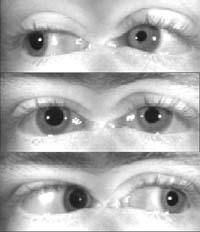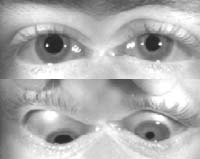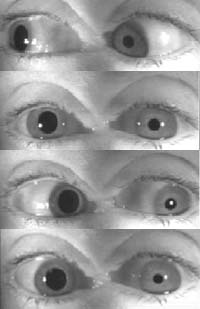Warning signs reveal aberrant nerve regeneration
Pupil dysfunctions and misdirection syndromes show when nerve endings re-innervated incorrectly.
 ---Aberrant
regeneration of iris sphincter by misdirected medial rectus nerve
fibers OS.
---Aberrant
regeneration of iris sphincter by misdirected medial rectus nerve
fibers OS.SOURCE: RANDY H. KARDON, MD, PHD
MONT TREMBLANT, Canada — Observation of abnormal pupil movements can help diagnose the aberrant nerve regeneration that causes misdirection syndromes, said Randy H. Kardon, MD, PhD.
Learning the pupil signs helps clinicians understand whether pathology is acute. So for the past decade, Dr. Kardon has used an infrared video system to record and review pupillary events to learn exactly what happens to the pupil after trauma or tumors cause nerve endings to re-innervate incorrectly.
Dr. Kardon spoke about aberrant regeneration of the pupil at the North American Neuro-Ophthalmology Society meeting here.
“Misdirection syndromes shouldn’t be a mystery to you if you understand what the cause is, what the sequence is, and how these nerves get to where they are not supposed to be,” he said. “Recognizing it is very important in terms of wondering whether it is primary or secondary aberrant re-innervation and knowing the cause of it.”
Types of misdirection
 ---Aberrant
regeneration of iris sphincter by misdirected inferior rectus nerve
fibers OS.
---Aberrant
regeneration of iris sphincter by misdirected inferior rectus nerve
fibers OS.SOURCE: RANDY H. KARDON, MD, PHD
Aberrant regeneration of the pupil involves the misdirected growth of nerves that re-innervate the iris sphincter or dilator muscle. The sprouting of the axons becomes misdirected in the wrong glial tubes, causing nerves to grow into the wrong muscle.
Primary aberrant regeneration involves simultaneous damage and repair to nerve endings. As re-innervation occurs, so does disorder, misdirection or regeneration.
“It’s not in the setting of an acute third nerve palsy,” he said. “It’s happening simultaneously and it’s caused by a compressive lesion, either a tumor or an aneurysm.”
Secondary aberrant regeneration results from an acute traumatic event, whether from surgery or a motor vehicle accident. About 12 weeks after the trauma, events that represent misdirection can occur.
Aberrant regeneration of the pupil is seen most commonly in the iris sphincter. Aide’s tonic pupil with light-near dissociation provides a good clinical example of misdirection syndrome.
Misdirected diagnosis
 ---Aberrant
regeneration of iris sphincter by misdirected accommodative nerve
fibers OS. Small left pupil that doesn’t change on gaze, but anisocoria
increases further with near effort.
---Aberrant
regeneration of iris sphincter by misdirected accommodative nerve
fibers OS. Small left pupil that doesn’t change on gaze, but anisocoria
increases further with near effort.SOURCE: RANDY H. KARDON, MD, PHD
The rule typically followed in misdirection syndromes of the oculomotor nerve is that when the patient converges, the lid goes up, the eye goes in and the pupil gets smaller. When the patient just tries to adduct the eye, there is some recovery of movement so the eye can get in but the pupil gets smaller and the lid goes up.
When the patient abducts the eye, the pupil undergoes a relative dilation because the firing of the misdirected nerves becomes quiet as the eye is moved into a position that does not stimulate the third nerve. However, when the patient tries to look up, the lid comes up again, and the pupil gets smaller. Similar symptoms can occur when the eye looks down, or in a position stimulating the third nerve.
But this is the exception, Dr. Kardon said. When nerve fibers have aberrantly regenerated, some fibers of some functional class get misdirected to some elements (lid, eye muscles or pupil sphincter) and not to others.
“So if you look for aberrant regeneration of all three, the lids, eye movement and pupil, all the time, you’re going to miss it,” he said.
Dr. Kardon reviewed 39 cases and looked for any signs of aberrant regeneration in either the pupil, the lid or motility. In about 78% of cases, he found some aberrant regeneration of the pupil. The pupil got smaller on adduction in some cases, or smaller on infraductions or supraductions or smaller with a combination.
The lid was involved in about 77% of cases, and motility in about 33%. These cases overlapped —56% involved both the pupil and lid, and 25% involved the pupil, lid and motility.
Pearls for diagnosis
Dr. Kardon follows several rules for diagnosing oculomotor nerve aberrant regeneration:
- Observe the pupils in bright and dim light for anisocoria.
- Put the normal iris sphincter innervation to rest by observing the pupils in dim light.
- Constriction of the pupil in a certain gaze position should be reproducible and repeatable for every observation.
- Look for abnormal near constriction of the pupil. Sometimes misdirected accommodative fibers are the culprit.
- Segmental iris contraction on gaze or accommodation may be overlooked without slit lamp magnification.
- Adie’s pupil may be the most common example of a misdirection syndrome of the iris sphincter.
“Be good observers, try to block out other aspects and look at the pupil independent of the other end organs and I think you’ll be able to pick aberrant regeneration up every time,” Dr. Kardon said.
For Your Information:
- Randy H. Kardon, MD, PhD, can be reached at the Department of Ophthalmology, University of Iowa Hospitals, Iowa City, IA 52242 U.S.A.; +(1) 319-356-2260; fax: +(1) 319-353-7996.
